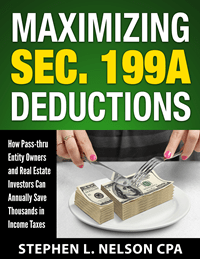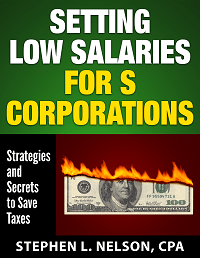 If you’re a real estate agent or broker, you may wonder whether the new Section 199A deduction works for you.
If you’re a real estate agent or broker, you may wonder whether the new Section 199A deduction works for you.
And the short answer: Probably you get the deduction. But the real estate broker Section 199A deduction is complicated. And not every agent or broker in the end saves tax.
Furthermore, some especially successful agents and brokers will miss out on the deduction simply due to lack of preparation,
This blog post, therefore, describes how the deduction works, explains why people initially thought real estate agents and brokers didn’t get the Section 199A deduction, and then ends with a discussion of why some successful agents and brokers will need to incorporate.
Note: I’m talking here about real estate agents and brokers. But all of what I describe also applies to insurance agents and brokers.
Section 199A Deduction in Nutshell
Section 199A gives businesses operating as sole proprietorships, partnerships and S corporations a special deduction. That deduction equals 20% of the business profit—though subject to some complicated accounting. Nevertheless, the basic deduction works pretty simply.
Example: A single taxpayer makes $100,000 in profit in their small business. Potentially, the taxpayer gets to add a $20,000 deduction to their tax return.
One important wrinkle: The Section 199A deduction can’t be greater than 20% of the taxpayer’s taxable income after deducting any capital gains. (In essence, this tweak means taxpayers can’t use the Section 199A deduction to shelter income already sheltered by other deductions or to shelter income already treated preferentially.)
Example: A single taxpayer makes $100,000 in profit from their small business. However, after deducting $30,000 of deductions on their tax return, the taxpayer’s taxable income equals $70,000. The Section 199A deduction in this case equals 20% of the $70,000 of taxable income and not 20% of the $100,000 of business income.
As noted, however, the deduction formula gets complicated. And the reason for the complication? Two phase-out calculations.
Specifically, if a single business owner’s taxable income rises above $157,500 or a married business owner’s taxable income rises above $315,000, one or two phase-outs reduce or potentially reduce the Section 199A deduction.
Note: The phase out dollar amounts get adjusted annually for inflation. The amounts I just gave apply for 2018 tax returns. For 2019, inflation will nudge the dollar values up.
The phase-out calculations get a little tricky—and lots of people got confused–but stay with me.
Understanding the Specified Service Trade or Business Phase-out
The first phase-out applies to many professional service businesses.
Specifically, if someone earns their business income in a “specified service trade or business,” the person begins losing their Section 199A deduction once their taxable income hits $157,500 or $315,000 in taxable income. (Those are the numbers I gave a few sentences ago.)
Further when a single person’s income hits $207,500 or a married person’s income hits $415,000, the person loses the Section 199A deduction if he or she earns their money in a specified service trade or business.
So what counts a specified service trade or business? Well, initially, things looked pretty bleak for realtors with taxable incomes into the phase-out range.
The actual law said that business owners involved in brokerage services should be treated as specified service trade or businesses. (That, at first blush, looked certain to hit the real estate brokerage firms, right?)
And then the law also said that any small business where the principal asset of the business is the skill or reputation of one or more owners should be treated as a specified service trade or business. (That looked certain to hit the successful agents operating as one-woman or one-man operations.)
But Agents and Brokers Don’t Lose Out
In the end, however, when the Internal Revenue Service wrote the regulations—the detailed rules about how the law works—they said a couple of key things.
First, they explicitly said that real estate brokerage services don’t get treated as the sort of brokerage services potentially disqualified from using the Section 199A deduction.
Because so many people got confused about this—and surely some still are—let me quote the actual language from the preamble to the regulations. Note the boldfaced and italicized sentence below. It provides the specified guidance,
Regulation §1.199A-5(b)(2)(x) uses the ordinary meaning of “brokerage services” and provides that the field of brokerage services includes services in which a person arranges transactions between a buyer and a seller with respect to securities (as defined in section 475(c)(2)) for a commission or fee. This includes services provided by stock brokers and other similar professionals, but does not include services provided by real estate agents and brokers, or insurance agents and brokers.
And then the second issue? That disqualification because the “principal asset of a business is the owner’s the skill or reputation”? Tax accountants and industry groups guessed that disqualification might apply to a successful one-person business. Like a superstar real estate agent.
But in the end, the IRS took another approach. Their regulations say that “principal asset is skill or reputation” disqualification only applies to celebrities earning income from endorsements, appearance fees, and licensing their name or image. (Think NFL quarterbacks Aaron Rogers and Peyton Manning selling insurance.)
But I’m getting off track. The point here? Realtors don’t need to worry about this.
That only leaves the second phase-out to worry about.
W-2 Wages and Depreciable Property Phase-out
That second phase-out? Some small businesses need to look at the W-2 wages or depreciable property of the business in order to determine their Section 199A deduction.
As with the specified service trade or business phase-out, the W-2 wages and depreciable property phase-out fully kicks in as a single person’s income hits $207,500 or a married person’s taxable income hits $415,000.
Furthermore, for a single person earning between $157,500 and $207,500 or a married person earning between $315,000 and $415,000, the W-2 wages and depreciable property phase-out works on a sliding scale.
The limitation? Your Section 199A deduction can’t exceed the greater of 50% of your W-2 wages or 25% of your W-2 wages plus 2.5% of your depreciable property.
Examples of When Wages Matter for Section 199A
In a service business, the depreciable property thing probably won’t matter. So what this limitation means is above those phase-out ranges ($207,500 for singles and $415,000 for married folks), W-2 wages matter.

Two examples probably show this best.
Example: A single taxpayer makes $250,000 a year as a real estate agent. Her tax deductions equal $25,000 putting her taxable income at $225,000. Her Section 199A deduction equals the lesser of 20% of her $250,000 of qualified business income (so that’s $50,000) or 20% of her $225,000 of taxable income (so that’s $45,000). But there’s a problem: Because her taxable income exceeds $207,500, her Section 199A deduction can’t exceed 50% of her wages. With wages equal to zero, 50% of wages equal zero. And that means she gets zero Section 199A deduction.
Example: The same single taxpayer earns $250,000 the very next year. However, the next year, she operates as a single employee single shareholder S corporation. She pays herself W-2 wages of $100,000 and the remaining $150,000 of business profit as qualified business income. Again, her deductions equal $25,000 so her taxable taxable income equals $225,000. In this case, her Section 199A deduction equals the lesser of 20% of her $150,000 of qualified business income (so that’s $30,000) or 20% of her $225,000 taxable income (so that’s $45,000). That means a $30,000 deduction as long as 50% of her W-2 wages equals at least $30,000. Her wages in this case equal $100,000 so 50% of W-2 wages equal $50,000. Yeah! She therefore gets the $30,000 deduction.
The obvious point in all this bookkeeping? A super successful agent or broker may need to operate as an S corporation to get the Section 199A deduction. Why? Because a super successful agent or broker may need W-2 wages. (That’s a whole new topic, but if you’re interested in learning more, check out this blog post: The Million Dollar S Corporation Mistake.)
Two Quick Comments in Closing
First, just so you know, no one really knew whether the Section 199A deduction worked for real estate agents and brokers until August 2018. (That’s when the IRS published proposed regulations.)

I mention that in case you wonder whether this opportunity is something where you or your accountant bungled the timing. You didn’t bungle.
Second, if you need wages to get the Section 199A deduction, probably you should form an LLC immediately. And then probably you would begin treating the LLC as an S corporation starting January 1st, 2019.
You should be able to get great information about the mechanics of doing this from your tax accountant. But note this means you’re out of luck for this year. The Section 199A deduction is something you’ll benefit from starting next year.
Note: We also provide a pretty rich FAQ on how S corporations work here.
Interested in More Small Business Insights?
We regularly blog about issues related to small business and small business ownership. Consider subscribing to our free monthly-ish newsletter. You can subscribe anytime.
Steve-
You mention that this article also applies to Insurance Agents as well. I’m trying to o address the issue of whether QBI includes statutory employees as well, specifically, Insurance Sales persons that receive a Form W-2 (with the Statutory Employee box checked, and report this income along with their associated expenses on Schedule C. The AICPA sent a letter to Treasury on 2/21/18 requesting guidance on a number of Section 199A issues and this being one of them. In a subsequent letter to Treasury (after the Proposed Regs came out in August, 2018) this item was no longer listed as being in need of clarification. I’m thinking that the issue turns on whether the Statutory employee is deemed to be more of an independent contractor than an ’employee’. Based on my understanding of the ‘common law’ rules, I would treat them as independent contractors for purposes of QBI and allow them the deduction. If you have any thoughts on this issue, it would be most appreciated.
John, good question–and one I don’t have an answer to. Or even a good comment. But I will share this remark: Is the regulation’s language about “common law employees” causing AICPA to see issue as resolved? I.e., it looks like employers only get to count W-2 wages for common law employees and corporate officers. (So not “non-common-law” or statutory employees?) And this would sort of suggest statutory employees who aren’t common law employees simply get treated as regular old sole proprietors.
Count me, however, as fuzzy on how this would work. (Sorry. We don’t have any statutory employees as clients…)
Steve,
Your contact web-page on the site says that if I have a question about an older article that the comments are closed on I should go to a recent article and post the question there so you’d see it.
I have a question about this. about the article here https://evergreensmallbusiness.com/s-corporation-partnerships/ where you wrote about the partnership of s-corporations,
Have you done any writing on how the substance over form doctrine or the step transaction doctrine applies to the use of a partnership of s-corps?
For example, suppose a business is created with two owners/partners. One owner can do a majority of what will create the customer value that earns all the money but he can’t do it alone and needs the assistance of a friend. The enticement for the friend to venture off with him is to get a small percentage of ownership. If they elect s-status the large difference between ownership percentages makes it hard for them to take distributions after receiving reasonable compensation. So a work around to give them flexibility could be to elect back to a partnership and then form s-corps like you your article said.
PS. I own a copy of the 199A ebook you wrote and it is fantastic. I just connected the dots that you authored the book and this site.
Hi Jay,
Thanks for kind words on the Section 199A ebook! Regarding the use of partnership to get around the usual S corporation limitations, here’s a good blog post that summarizes situation and points to primary sources: https://www.taxlawforchb.com/2015/11/partnering-with-an-s-corp/
Steve, That helps. Especially the last part of that article. Thank you!
In one of your notes it says “The phase out dollar amounts get adjusted annually for information.” I assume that should say inflation?
Examples all seem to be single taxpayers. How does the deduction affect married taxpayers where one is a sole proprietor and the other a w-2 employee, assuming equal taxable numbers like 50k each? What seems like a straightforward deduction, section 199a seems awfully complicated. Does your book cover issues like that?
I corrected “information” to “inflation”… thanks for pointing that out. The phase-out ranges and formulas, as noted in the article, do apply to married couples but use a different range. Singles phase out from $157,500 to $207,500. Marrieds phase out from $315,000 to $415,000.
The “Maximizing Section 199A Deductions” monograph does into deep detail about the law. But there’s also pretty detailed discussions in the Section 199A Phase-out Calculations blog post.